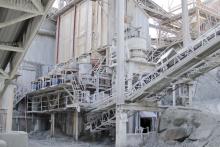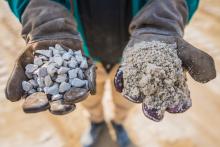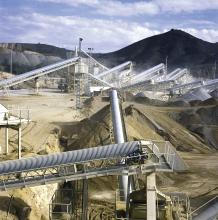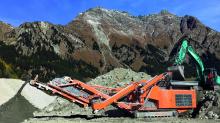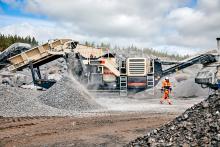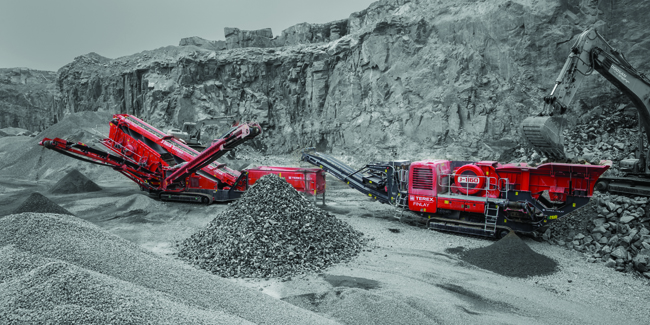
By tonnage, crushing is by far the largest operation in aggregates processing. To do it cost effectively, it’s always important to deploy the right crusher for the application.
This not only saves you time, but it will also save you money in the long run. Munesu Shoko reports.
Regarded as the main process in aggregates production, crushing is the first controlled size reduction stage and is the basis for optimal further size reduction. It is, therefore, important that when choosing a new rock crusher, the first thing you need to know is which one best matches your material – and it is imperative to find the right one the first time.
Just how important is crushing in the whole aggregates production equation? Reiterating the significance of the process, Heath Dickson, national mining sales manager at ELB Equipment, says “simply put, without crushing, in specification aggregate would not exist”.
Sandro Scherf, CEO of
Tyron Ravenscroft, Finlay Product Manager at
Johann Prüwasser, engineer at
It is important to deploy the right crusher for the right application. There are different types of crushers available in the market, ranging from jaws to cone and impact crushers. Scherf says for the long-term profitability of any operation, it’s imperative to have the correct type and size of crusher in a correct application.
He reasons that a jaw crusher is universally applicable in primary crushing applications and is used to reduce large material to a more manageable size. “From the hardest of granite or basalt, to the softest of sedimentary, the jaw crusher is a compression crusher that takes large primary material and reduces it to a manageable size for further crushing. In some cases, granulator jaw crushers can be used in secondary applications,” says Scherf.
Prüwasser reasons that generally jaw crushers are provided for abrasive to very abrasive materials as primary crushers. Cone crushers are mainly used for abrasive to very abrasive materials as secondary crushers. Ravenscroft agrees, saying that a jaw is predominantly classified as a primary crusher, by virtue of being the first stage in the crushing process. “It caters for large feed size and a high production output, with a crushing ratio of 4/5:1,” says Ravenscroft.
Scherf says while there are primary gyratory crushers (similar in operating principle to a cone crusher), cone crushers are generally used as secondary or tertiary crushers. “Cone crushers are also compression crushers and offer a greater ability to adjust your final product size and shape than a jaw crusher and operate at a lower cost per tonne than an impact crusher in hard or abrasive feeds,” says Scherf.
Ravenscroft says a cone crusher is classified as a secondary and/or tertiary crusher. “It further reduces the size of the rock at a 4/5:1 ratio and supplying desired end product sizes. Cone crushers can also supply a quality shaped product by using the crusher within its desired parameters and crushing ratios,” he says.
When it comes to horizontal shaft impactors (HSI), Dickson says as long as the client understands the wear costs and ultimately the cost per tonne to produce, there is a place for this type of crusher in most applications, especially demolition, recycling of asphalt and applications where the client needs high reduction of material.
Scherf says while it can be used as a primary crusher in certain applications, a horizontal shaft impactor comes to the fore as a secondary or tertiary crusher in softer, non-abrasive rocks such as limestone. “As the name implies, it crushes using the impact of the feed material against metal hammers. Perhaps the most versatile of all the crusher types, offering the best in terms of reduction ratio and producing a cubicle product, the operating cost in abrasive or hard feed materials limits its practical applications,” says Scherf.
Ravenscroft says impact crushers can be classified as primary/secondary crushers or secondary/tertiary crushers. He adds that they have a higher crushing ratio of up to 10:1. They are more acceptable to larger feed sizes than cone crushers, but still giving an output size similar to cone crushers.
As far as the vertical shaft impactor (VSI) crusher is concerned, Scherf argues that this is the most misunderstood of all crushers and is often called a ‘shaping’ crusher. He explains that the VSI is an impact crusher that uses a rotor to accelerate material and sling it against a rock wall built around the rotor. The VSI is a critical part in obtaining high-specification road stone, or as a pre-milling crusher to increase mill throughput in mining applications. It is often used in sand-making applications, especially in applications such as silica sand and other abrasive feeds where the operating cost of an HSI would be too high.
Is geology a factor that determines the type of crusher to be deployed in an application? Dickson says the end result the client is looking for would determine what crusher gets deployed for the job. “Ideally you would not want to necessarily deploy an HSI into a high silica application, but if the client is looking to maximise the fines generation and understands the wear costs or cost per tonne, this could be an option,” says Dickson, adding that capital expenditure (capex) vs tonnage can be a major factor when deciding what crusher to deploy.
Ravenscroft is of the view that knowing the geology of the material is very important as materials react differently when under pressure or impact in the crushing chambers. “Knowing the geology of the material assists in specifying the correct crusher for the specific rock application. Further to this, knowing the product size distribution of the Run of Mine (ROM) allows the crusher to be spec’d correctly. Should there be a high fraction of fines in the feed ROM, pre-screens can be fitted to the jaw, cone and impact crushers,” he says.
According to Scherf, in order to operate economically and safely, having the correct crusher for feed material is critical. For instance, in a coal application, using a cone crusher carries a very high risk of igniting the coal, due to the compression of the material in a small chamber. He is of the view that using an HSI on a very hard granite or basalt can result in the hammers breaking at worst, or very high operating costs at best.
“Knowing the silica content or abrasion index of the feed material is critical in selecting not only the correct crusher, but also the correct wearing materials to ensure a profitable operation,” says Scherf. He adds that rock properties, even on the same rock types, vary considerably as they are produced in a natural and varying environment, not a controlled lab.
“Not all granites are the same, a fine grain granite is significantly harder than a coarse grain granite; some will have a higher silica (SiO2) content than others. In order to manage customer expectations and operating costs, we generally send rock samples to the
Scherf also reasons that harder material will have an impact on the number of crushing stages. “The harder the rock the more energy required to break it down. Similar to a racing car, using different gear ratios depending on the race track, efficient and economical operation of a plant requires fine tuning to take the material properties into account,” he says.
Prüwasser says a good host rock is vital for production of a quality product, and the geology of the host rock is relevant right from the blasting stages of aggregates production. This tends to affect the size of the material that will report to the crushers, and hence will determine the size of the jaw crusher required at primary stage.
“The hardness of the material will also affect the primary crusher selection and may well impact the throughput that can be achieved through the crushing circuit. Silica levels and other abrasiveness factors will influence wear levels, so operators need to be aware that maintenance interventions may be more frequent under these conditions,” concludes Prüwasser.

